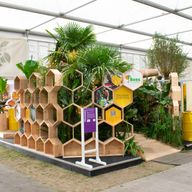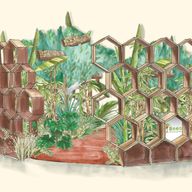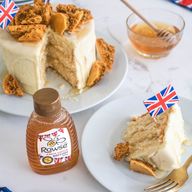
From plant to plate, add style and substance to your kitchen creations all-year round with our edible flower guide.
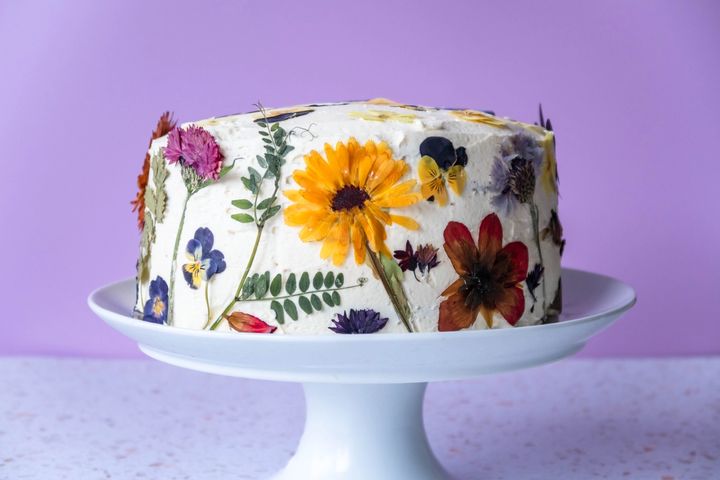
As edible flowers grace the plates of models and influencers all over Instagram, they’ve become a symbol of luxury. This foodie trend is here to stay, with 45 million views on TikTok. Captivating on cakes and sensational on salads, edible flowers add style to every dish.
Not just a decoration, edible flowers also have a unique taste, so they add not only style but substance to your plate. From the almond-y taste of appetising hawthorn to the subtly spicy essence of cornflower, edible flowers will help you unlock a whole new flavour palate.
The benefits of edible flowers are plentiful. They not only enrich our flavour palates, but growing them can help to feed pollinating insects like honey bees all year round. And it’s vitally important – without pollinators, around 30% of the crops we consume wouldn’t even make it to our plates! That’s why we’ve made it our mission to protect the bees by restoring vital nectar sources.
Our Hives for Lives programme of initiatives is all about supporting the bees and beekeepers. We work with three partners to protect the honey-making heroes – the Bee Farmers Association (BFA), Bees For Development (BFD) and The Laboratory of Apiculture and Social Insects (LASI) at the University of Sussex.
Bees and other pollinating insects are vital to our ecosystem, and we can benefit them whilst also bringing a little extra flavour to our own lives. Just planting a few nectar-rich, edible flowers fit for every season in your own garden can do a whole world of good.
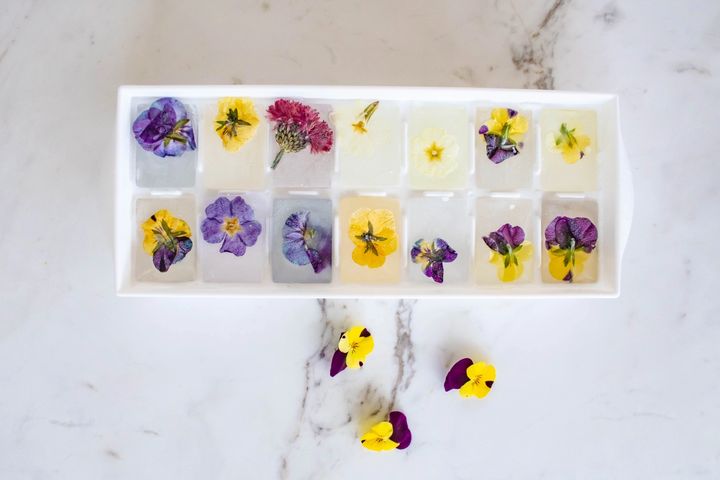
From Valentine’s Day dinner all the way through to Christmas party treats, you can add edible flowers to your kitchen creations all-year round. To help you navigate the best blooms to cook and bake with in every season, here are our top 12 edible flowers you should be using in the kitchen:
- Chive blossoms – the popping purple blossoms that grow on chives are edible as well as the herb itself! Chive blossoms are ready April and May, and you can pull apart the large flowers into smaller florets and sprinkle them over all kinds of salads.
- Crab apple tree blossoms – pretty pink or whimsical white crab apple tree blossoms burst into life from March to May and are a great early nectar source for bees. They give us a charming cocktail garnish, ready in spring.
- Hawthorn – It’s not only the berries from a Hawthorn plant that you can eat – the late spring blooms are a fantastic ingredient for delicious cordials or brew in boiling water to make a warming tea.
- Cornflower – Deep purple cornflower blooms from June to September, and its neutral flavour makes it one of the most versatile edible flowers you can use in the kitchen. It’s perfect in both sweet and savoury dishes, whether the petals are mixed into salads or delicately arranged on a cake.
- Elderflower – Elegant elderflower is well known for its use in cordials, and its familiar flavour can also be cooked into delicious cakes and biscuits. The delicate flowers bloom from May to August, but it’s important not to eat foraged elderflowers raw – always cook them to destroy the plant’s mild toxins.
- Lavender – Earthy, minty lavender is a popular culinary herb, used in baking, sweets, and even alcoholic drinks. This pretty purple bloom is ready in June and July.
- Borage – Beautiful borage is a plant that bees love best. It’s also yummy for humans – it has a sweet flavour, and some even say it tastes like honey! The striking flower, which blooms all the way from May until November, looks magnificent frozen into ice cubes for your summer cocktails.
- French Marigolds – Vibrant and bitter French marigolds flower from July to September and add a pop of warm colour to decorated cakes and a glamorous garnish to desserts.
- Nasturtiums – With a peppery kick, nasturtiums are incredibly easy to grow in the garden and pair well with savoury salads, but they can also be used to infuse vinegars and alcohols too. The flowers will bloom late into the season, even into October.
- Dahlias – Intricate dahlias flower from July to November, and different varieties have different flavours, ranging from subtly spicy to crisp and bland. If you grow dahlias in the garden, you’ll even have a two-for-one – you can also eat dahlia tubers which make fantastic rostis.
- Primrose – Colourful primrose flowers bloom in the colder months, from December to May. They have a mildly sweet flavour and look beautiful on banquet tables and in Christmas party cocktails.
- Violas – Popular edible violas flower all year round and have a sweet flavour which is almost slightly minty. They’ve been popularised by Marks & Spencer, who sell packs of edible viola flowers.
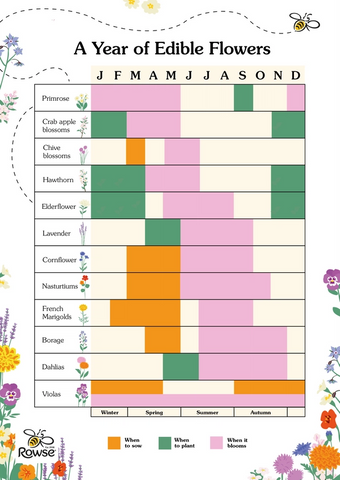
Most edible flowers can be pressed, which means they can be enjoyed for months after their growing season.
Pressed violas are perfect atop delicious beetroot and rose tartlets for Christmas party season, like these from Erin at The Edible Flower.
Pressed flowers are so delicate they make a perfect garnish for little canapes and tartlets. You can press them when the flowers are in season and then store them for months, meaning you can use them for your special occasions throughout the year.Just pick the flowers you want to press on a dry day and arrange them, face down, on a sheet of clean paper inside a large book. Once you have filled the sheet add another clean sheet of paper on top and close the book. Weigh the book down evenly with something heavy (more books) and leave for two weeks. The flowers will be dry when fully pressed and ready to use.Make sure you source your edible flowers from reputable growers or grow them yourself, you need to make sure they haven’t been sprayed with any pesticides or herbicides.

